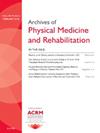Reductions in Therapy Provision in Skilled Nursing Facilities After Medicare Payment Reform and During the COVID-19 Pandemic: An Interrupted Time Series Analysis
IF 3.7
2区 医学
Q1 REHABILITATION
Archives of physical medicine and rehabilitation
Pub Date : 2025-10-01
DOI:10.1016/j.apmr.2025.05.020
引用次数: 0
Abstract
Objective
To examine how rehabilitation service provisions (ie, physical therapy [PT], occupational therapy [OT], speech language pathology [SLP]) changed in skilled nursing facilities (SNFs) after Medicare implemented the Patient-Driven Payment Model (PDPM) and the COVID-19 pandemic began, while comprehensively accounting for changes in patient clinical characteristics.
Design
Secondary interrupted time series analysis of 100% Medicare data from January 2018 to September 2021 with interruptions for PDPM implementation (October 2019) and COVID-19 (March 2020).
Setting
United States SNFs.
Participants
All SNF stays for fee-for-service Medicare beneficiaries admitted to SNF within 3 days of hospitalization with complete data from SNF assessments and hospital claims. Stratified analyses included stays with facility data on ownership status and rural versus urban location.
Interventions
Not applicable.
Main Outcome Measures
Average total minutes of therapy per day (MTD) provided by assistants or therapists and MTD by discipline (ie, PT, OT, SLP).
Results
For 3,917,261 SNF stays, PDPM implementation was associated with a decline of 28.9 total MTD, representing a relative reduction of 23.7%, compared to pre-PDPM averages. PT declined by 12.8 MTD (−23.5%), OT by 12.9 MTD (−24.3%), and SLP by 3.1 MTD (−21.7%). PDPM-associated declines were larger in for-profit SNFs versus not-for-profit and government-owned SNFs and in rural versus urban SNFs. Compared to what would have occurred if post-PDPM negative trends continued, COVID-19 was associated with a 15.3 minute (15.9%) increase in total MTD, a 5.4 minute (12.8%) increase for PT, a 5.1 minute (12.3%) rebound for OT, and a 4.5 minute (38.9%) increase for SLP, with greater relative increases in urban and for-profit SNFs.
Conclusions
Even when accounting for changing patient characteristics over time, PDPM implementation was associated with substantial declines in therapy provision, particularly in for-profit and rural SNFs. After COVID-19, these steep declines stabilized, with a slight recovery for SLP, but lower levels of PT and OT MTD persisted well into the pandemic.
医疗保险支付改革后和COVID-19大流行期间熟练护理机构治疗供应减少:一项中断的时间序列分析
目的:探讨医疗保险实施患者驱动付费模式(PDPM)和COVID-19大流行开始后,熟练护理机构(snf)康复服务提供(即物理治疗(PT)、职业治疗(OT)和言语语言病理学(SLP))的变化,同时综合考虑患者临床特征的变化。设计:对2018年1月至2021年9月100%医疗保险数据进行二次中断时间序列分析,其中PDPM实施(2019年10月)和COVID-19(2020年3月)中断。背景:美国snf。参与者:住院3天内接受SNF治疗的所有按服务收费的医疗保险受益人的SNF住院,并提供SNF评估和医院索赔的完整数据。分层分析包括设施所有权状况和农村与城市位置的住宿数据。干预措施:不适用。主要结果测量:助理或治疗师每天提供的平均总治疗分钟数(MTD),以及按学科(即PT, OT, SLP)划分的MTD。结果:在3,917,261名SNF患者中,PDPM实施与总MTD下降28.9相关,与PDPM前的平均水平相比,相对减少了23.7%。PT下降了12.8 MTD (-23.5%), OT下降了12.9 MTD (-24.3%), SLP下降了3.1 MTD(-21.7%)。与pdpm相关的下降在营利性snf中大于非营利和政府所有的snf,在农村snf中大于城市snf。与pdpm后阴性趋势持续的情况相比,COVID-19与总MTD增加15.3分钟(15.9%)、PT增加5.4分钟(12.8%)、OT反弹5.1分钟(12.3%)和SLP增加4.5分钟(38.9%)相关,城市和营利性snf的相对增加幅度更大。结论:即使考虑到随着时间的推移患者特征的变化,PDPM的实施也与治疗提供的大幅下降有关,特别是在营利性和农村snf。在2019冠状病毒病之后,这些急剧下降趋于稳定,SLP略有回升,但PT和OT MTD的较低水平一直持续到大流行。
本文章由计算机程序翻译,如有差异,请以英文原文为准。
求助全文
约1分钟内获得全文
求助全文
来源期刊
CiteScore
6.20
自引率
4.70%
发文量
495
审稿时长
38 days
期刊介绍:
The Archives of Physical Medicine and Rehabilitation publishes original, peer-reviewed research and clinical reports on important trends and developments in physical medicine and rehabilitation and related fields. This international journal brings researchers and clinicians authoritative information on the therapeutic utilization of physical, behavioral and pharmaceutical agents in providing comprehensive care for individuals with chronic illness and disabilities.
Archives began publication in 1920, publishes monthly, and is the official journal of the American Congress of Rehabilitation Medicine. Its papers are cited more often than any other rehabilitation journal.

 求助内容:
求助内容: 应助结果提醒方式:
应助结果提醒方式:


